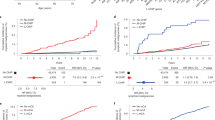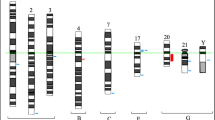Abstract
Although acquired uniparental disomy (aUPD) has been reported in relapse acute myeloid leukemia (AML), pretransplant aUPD involving chromosome 6 is poorly documented. Such events could be of interest because loss of heterozygosity (LOH) resulting from aUPD in leukemic cells may lead to erroneous results if HLA typing for hematopoietic stem cell donor searches is performed on blood samples drawn during blastic crisis. We report here six AML patients whose HLA typing was performed on DNA extracted from peripheral blood obtained at diagnosis. We observed LOH involving the entire HLA region (three patients), HLA-A, B, C (two patients) and HLA-A only (one patient). An array-comparative genomic hybridization showed that copy number was neutral for all loci, thus revealing partial aUPD of chromosome 6p21. When HLA typing was performed on remission blood samples both haplotypes were detected. A 3–4% LOH incidence was estimated in AML patients with high blast counts. Based on DNA mixing experiments, we determined by PCR sequence-specific oligonucleotide hybridization on microbeads arrays a detection threshold for HLA-A, B, DRB1 heterozygosity in blood samples with <80% blasts. Because aUPD may be partial, any homozygous HLA result should be confirmed by a second typing performed on buccal swabs or on blood samples from the patient in remission.
This is a preview of subscription content, access via your institution
Access options
Subscribe to this journal
Receive 12 print issues and online access
$259.00 per year
only $21.58 per issue
Buy this article
- Purchase on Springer Link
- Instant access to full article PDF
Prices may be subject to local taxes which are calculated during checkout



Similar content being viewed by others
References
Garrido F, Ruiz-Cabello F, Cabrera T, Pérez-Villar JJ, Lopez-Botet M, Duggan-Keen M et al. Implications for immunosurveillance of altered HLA class I phenotyped in human tumors. Immunol Today 1997; 18: 89–95.
Marincola FM, Jaffee EM, Hicklin DJ, Ferrone S . Escape of human solid tumors from T-cell recognition: molecular mechanisms and functional significance. Adv Immunol 2000; 74: 181–273.
Wetzler M, Baer MR, Stewart SJ, Donahue K, Ford L, Stewart CC et al. HLA class I antigen cell surface expression is preserved on acute myeloid leukemia blasts at diagnosis and at relapse. Leukemia 2001; 15: 128–133.
Masuda K, Hiraki A, Fujii N, Watanabe T, Tanaka M, Matsue K et al. Loss or down-regulation of HLA class I expression in freshly isolated leukemic blasts. Cancer Sci 2007; 98: 102–108.
Vago L, Perna SR, Zanussi M, Mazzi B, Barlassina C, Lupo MT et al. Loss of mismatched HLA in leukemia after stem-cell transplantation. New Engl J Med 2009; 361: 478–488.
Villalobos IB, Takahashi Y, Akatsuka Y, Muramatsu H, Nishio N, Hama A et al. Relapse of leukemia with loss of mismatched HLA resulting from uniparental disomy after haploidentical hematopoietic stem cell transplantation. Blood 2010; 115: 3158–3161.
Waterhouse M, Pfeifer D, Pantic M, Emmerich F, Bertz H, Finke J . Genome-wide profiling in AML patients relapsing after allogeneic hematopoietic cell transplantation. Biol Blood Marrow Transpl 2011; 17: 1450–1457.
Tuna M, Knuutila S, Mills GB . Uniparental disomy in cancer. Trend Mol Med 2009; 15: 120–128.
Raghavan M, Lillington DM, Skoulakis S, Debernardi S, Chaplin T, Foot NJ et al. Genome-wide single nucleotide polymorphism analysis reveals frequent uniparental disomy due to somatic recombination in acute myeloid leukemias. Cancer Res 2005; 65: 375–378.
Gorletta T, Gasparini P, D’Elios MM, Trubia M, Pelicci PG, Di Fiore PP . Frequent loss of heterozygosity without loss of genetic material in acute myeloid leukemia with a normal karyotype. Genes Chromosomes Cancer 2005; 44: 334–337.
Serrano E, Carnicer MJ, Orantes V, Estivill C, Lasa A, Brunet S et al. Uniparental disomy may be associated with microsatellite instability in acute myeloid leukemia (AML) with normal karyotype. Leuk Lymphoma 2008; 49: 1178–1183.
Raghavan M, Smith LL, Lillington DM, Chaplin T, Kakkas I, Molloy G et al. Segmental uniparental disomy is a commonly acquired genetic event in relapsed acute myeloid leukemia. Blood 2008; 112: 814–821.
Gupta M, Raghavan M, Gale RE, Chelata C, Allen C, Molloy G et al. Novel regions of acquired uniparental disomy discovered in acute myloid leukemia. Genes Chromosomes Cancer 2008; 47: 729–739.
Bullinger L, Krönke J, Schön C, Radtke I, Urlbauer K, Botzenhardt U et al. Identification of acquired copy number alterations and uniparental disomies in cytogenetically normal acute myeloid leukemia using high-resolution single-nucleotide polymorphism analysis. Leukemia 2010; 24: 438–449.
Itsara A, Wu H, Smith JD, Nickerson DA, Romieu I, London SJ et al. De novo rates and selection of large copy number variation. Genome Res 2010; 20: 1469–1481.
Pereira S, Vayntrub T, Hiraki DD, Cherry AM, Arai S, Dvorak CC et al. Short tandem repeat and human leukocyte antigen mutations or losses confound engraftment and typing analysis in hematopoietic stem cell transplants. Human Immunol 2011; 72: 503–509.
http://www.efiweb.eu/index.php?id=129. EFI Standards for histocompatibility testing, 2009.
Brazma D, Grace C, Howard J, Melo JV, Holoyke T, Apperly JF et al. Genomic profile of chronic myeloenous leukemia: imbalances associated with disease progression. Genes Chromosomes Cancer 2007; 46: 1039–1050.
Shah N, Decker WK, Lapushin R, Xing D, Robinson SN, Yang H et al. HLA homozygosity and haplotype bias among patients with chronic lymphocytic leukemia: implications for disease control by physiological immune surveillance. Leukemia 2011; 25: 1036–1039.
Katagiri T, Sato-Otsubo A, Kashiwase K, Morishima S, Sato Y, Mori Y et al. Frequent loss of HLA alleles associated with copy number-neutral 6pLOH in acquired aplastic anemia. Blood 2011; 118: 6601–6609.
Acknowledgements
We are grateful to Dr A Devys, P Herry (EFS Nantes) and I Mollet (EFS Lyon) for their technical support. This study has been supported by the Swiss National Science Foundation (Grant 320030_130483).
Author information
Authors and Affiliations
Corresponding author
Ethics declarations
Competing interests
The authors declare no conflict of interest.
Rights and permissions
About this article
Cite this article
Dubois, V., Sloan-Béna, F., Cesbron, A. et al. Pretransplant HLA mistyping in diagnostic samples of acute myeloid leukemia patients due to acquired uniparental disomy. Leukemia 26, 2079–2085 (2012). https://doi.org/10.1038/leu.2012.68
Received:
Revised:
Accepted:
Published:
Issue Date:
DOI: https://doi.org/10.1038/leu.2012.68
Keywords
This article is cited by
-
HLA-haplotype loss after TCRαβ/CD19-depleted haploidentical HSCT
Bone Marrow Transplantation (2021)
-
Acquired uniparental disomy in chromosome 6p as a feature of relapse after T-cell replete haploidentical hematopoietic stem cell transplantation using cyclophosphamide tolerization
Bone Marrow Transplantation (2017)
-
Are changes in HLA Ags responsible for leukemia relapse after HLA-matched allogeneic hematopoietic SCT?
Bone Marrow Transplantation (2015)
-
Incidence, risk factors and clinical outcome of leukemia relapses with loss of the mismatched HLA after partially incompatible hematopoietic stem cell transplantation
Leukemia (2015)



